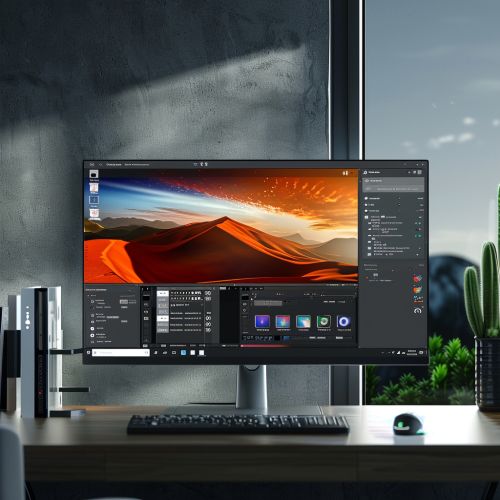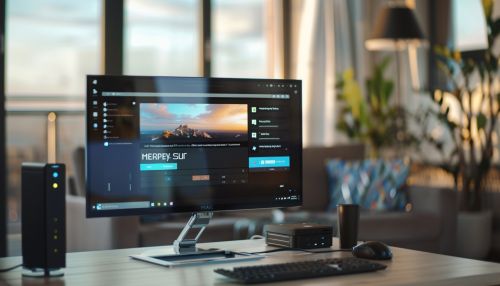Mir (software): Difference between revisions
No edit summary |
No edit summary |
||
| Line 62: | Line 62: | ||
Mir represents a significant effort to modernize the display server architecture for Linux-based systems. While it has faced challenges and criticisms, it has also demonstrated its potential as a high-performance, secure, and flexible display server. As development continues, Mir is likely to play an increasingly important role in the Linux ecosystem, particularly in areas such as embedded systems and IoT devices. | Mir represents a significant effort to modernize the display server architecture for Linux-based systems. While it has faced challenges and criticisms, it has also demonstrated its potential as a high-performance, secure, and flexible display server. As development continues, Mir is likely to play an increasingly important role in the Linux ecosystem, particularly in areas such as embedded systems and IoT devices. | ||
[[Image:Detail-79745.jpg|thumb|center|A modern computer screen displaying a graphical user interface running on Mir.]] | [[Image:Detail-79745.jpg|thumb|center|A modern computer screen displaying a graphical user interface running on Mir.|class=only_on_mobile]] | ||
[[Image:Detail-79746.jpg|thumb|center|A modern computer screen displaying a graphical user interface running on Mir.|class=only_on_desktop]] | |||
== See Also == | == See Also == | ||
Latest revision as of 00:39, 20 May 2024
Introduction
Mir is a display server and windowing system developed by Canonical Ltd. for the Ubuntu operating system. Initially designed to replace the X Window System, Mir aims to provide a more modern and efficient framework for graphical user interfaces (GUIs) on Linux-based systems. Its development began in 2013, and it has since evolved to support a variety of use cases, including desktop environments, embedded systems, and IoT devices.
History and Development
The development of Mir was announced by Canonical in March 2013. The primary motivation behind Mir was to create a display server that could better meet the needs of modern computing environments, particularly in terms of performance, security, and flexibility. Canonical intended Mir to replace the aging X Window System, which had been the standard display server for Unix-like operating systems for decades but was increasingly seen as outdated and inefficient.
Mir was initially developed alongside the Unity desktop environment, which was also created by Canonical. The goal was to integrate Mir with Unity to provide a seamless and efficient user experience on Ubuntu. However, in 2017, Canonical announced that it would discontinue the development of Unity and switch to the GNOME desktop environment for future releases of Ubuntu. Despite this shift, development of Mir continued, with a focus on supporting a wider range of use cases beyond just desktop environments.
Architecture
Mir's architecture is designed to be modular and flexible, allowing it to be adapted for different types of devices and use cases. The core components of Mir include:
- **Display Server**: The central component of Mir, responsible for managing the display and handling input from devices such as keyboards and mice.
- **Compositor**: A subsystem that combines the contents of different windows and applications into a single image that can be displayed on the screen.
- **Input Handling**: A subsystem that processes input events from various devices and forwards them to the appropriate applications.
- **Wayland Support**: Mir includes support for the Wayland protocol, allowing it to function as a Wayland compositor and provide compatibility with Wayland-based applications.
Mir's architecture is designed to be highly efficient, with a focus on minimizing latency and maximizing performance. This is achieved through techniques such as direct rendering, which allows applications to render directly to the screen without the need for intermediate buffers.
Features
Mir offers a range of features designed to support modern graphical applications and environments. Some of the key features include:
- **High Performance**: Mir is designed to provide high performance and low latency, making it suitable for demanding applications such as gaming and virtual reality.
- **Security**: Mir includes features such as secure input handling and sandboxing to enhance the security of graphical applications.
- **Flexibility**: Mir's modular architecture allows it to be adapted for different types of devices and use cases, from desktop environments to embedded systems and IoT devices.
- **Compatibility**: Mir includes support for the Wayland protocol, allowing it to be used with Wayland-based applications and toolkits.
Use Cases
Mir is used in a variety of different contexts, including:
- **Desktop Environments**: While Canonical initially developed Mir for use with the Unity desktop environment, it can also be used with other desktop environments such as KDE Plasma and LXQt.
- **Embedded Systems**: Mir's lightweight and efficient architecture makes it well-suited for use in embedded systems, such as automotive infotainment systems and smart appliances.
- **IoT Devices**: Mir can be used to provide graphical interfaces for IoT devices, such as smart home controllers and industrial automation systems.
Adoption and Community
Despite its initial focus on Ubuntu, Mir has seen adoption by other projects and distributions. For example, the UBports project, which maintains the Ubuntu Touch mobile operating system, uses Mir as its display server. Additionally, Mir has been integrated into various Linux distributions and projects that require a lightweight and efficient display server.
The Mir project is open source, and its development is driven by a community of contributors. Canonical continues to play a significant role in the development of Mir, but contributions are also welcomed from other developers and organizations.
Challenges and Criticisms
Mir has faced several challenges and criticisms over the course of its development. One of the main criticisms has been the fragmentation of the Linux display server ecosystem, with some arguing that the development of Mir has contributed to this fragmentation. Critics have also pointed out that Mir's initial focus on Ubuntu and Unity limited its adoption by other projects and distributions.
However, the Mir project has made efforts to address these criticisms by increasing its compatibility with other desktop environments and applications, and by fostering a more inclusive and collaborative development community.
Future Directions
The future of Mir is focused on continuing to improve its performance, security, and flexibility. Some of the key areas of development include:
- **Enhanced Wayland Support**: Improving Mir's support for the Wayland protocol to ensure compatibility with a wider range of applications and toolkits.
- **Performance Optimization**: Ongoing efforts to optimize Mir's performance, particularly for demanding use cases such as gaming and virtual reality.
- **Security Enhancements**: Adding new security features and improving existing ones to provide a more secure environment for graphical applications.
- **Broader Adoption**: Encouraging adoption of Mir by other projects and distributions, and fostering a collaborative development community.
Conclusion
Mir represents a significant effort to modernize the display server architecture for Linux-based systems. While it has faced challenges and criticisms, it has also demonstrated its potential as a high-performance, secure, and flexible display server. As development continues, Mir is likely to play an increasingly important role in the Linux ecosystem, particularly in areas such as embedded systems and IoT devices.


